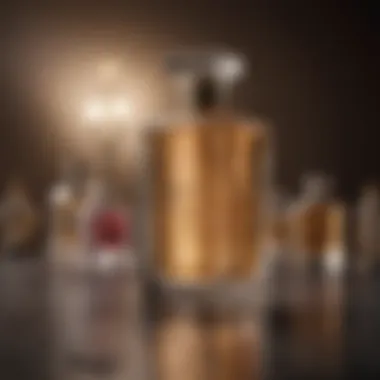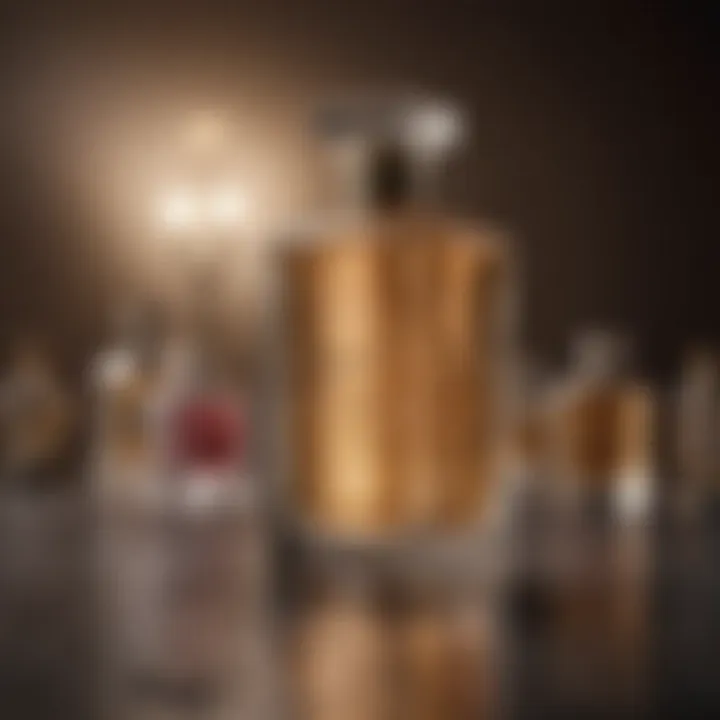The Pursuit of the Best Smelling Perfume for Women


Intro
The quest for the perfect perfume often begins with a simple idea: a fragrance that resonates with one's identity. As women, the variety of options can be as vast as the emotions tied to memory and experience. Navigating this landscape requires more than just sampling scents; it involves understanding the relationship between scent and personality, occasion, and season.
Fragrances can evoke feelings, communicate a mood, and even influence social interactions. The significance of choosing the right scent extends beyond personal preference. Each fragrance family carries its own traits, influencing how one is perceived. It is crucial to consider these aspects to make informed decisions.
In this guide, we will examine key factors that shape one's perfume choices. From understanding different fragrance families, to how culture impacts preferences, readers will find a nuanced examination of the world of women's perfumes. Recommendations tailored for varying occasions and practical tips for effective use will empower women to embrace their chosen scents with assurance.
Tips and How-Tos
In the pursuit of selecting the ideal fragrance, practical guidance is essential. Knowing how to choose and apply perfume can enhance the overall experience. Here are some tips focused on discovering the right perfume and making the most of it.
Understanding Fragrance Families
Perfumes are typically categorized into fragrance families. Recognizing these groups can help narrow down selections:
- Floral: These scents are aromatic and often include notes from various flowers. They can range from light and airy to rich and decadent.
- Oriental: Characterized by warm spices and rich resins, this family tends to evoke a sense of warmth and sensuality.
- Fruity: Fresh and vibrant, fruity perfumes tend to elicit feelings of fun and playfulness.
- Woody: Featuring earthy notes like sandalwood and cedar, these scents often convey strength and resilience.
Choosing the Right Scent for Occasions
Different occasions call for different scents. Here are some suggestions:
- Daily Wear: Choose lighter fragrances that feel refreshing and suitable for a typical day.
- Evening Events: Opt for bolder scents that carry depth and complexity. These fragrances linger long into the night.
- Special Occasions: Consider unique or signature scents that resonate with personal history or important moments.
Application Techniques
How you apply perfume can influence how it develops on your skin. Here are some effective techniques:
- Pulse Points: Apply perfume to pulse points like wrists, neck, and behind the ears. These warm areas help release the fragrance into the air.
- Layering: Use complementary scented body lotions before applying perfume. This can enhance the overall scent profile.
- Don’t Rub: After applying, avoid rubbing the area. Rubbing can break down the fragrance notes, altering how it smells throughout the day.
"Choosing a fragrance is about selecting a personal signature that enhances your identity. It's not just about smell; it’s about feeling."
Incorporating these practical tips can streamline the search for that coveted scent while fostering a deeper appreciation for the nuances that perfume embodies.
Understanding Perfume
Perfume has been an essential part of human culture for centuries. Its importance goes beyond merely smelling pleasant. Fragrance is a personal expression, a reflection of one’s identity, and an influential factor in interpersonal relationships. Understanding the intricacies of perfume can elevate not only the experience of selecting a fragrance but also enhance one’s connection to it. Knowing how various components contribute to a scent allows for more informed choices, aligning personal preference with the essence of the fragrance. In this section, we will examine the foundational aspects of perfume, focusing on its composition and the underlying mechanisms that drive scent perception.
The Composition of Fragrances
The role of top notes
Top notes are the initial impressions of a fragrance. They are what one smells immediately upon application. Commonly lighter in nature, citrus and herbal notes often dominate this category. The role of top notes is crucial because they shape the first reaction to a perfume. Their transitory nature means they typically last only a short time, lasting anywhere from 15 minutes to a couple of hours. This can be beneficial, as they may attract attention with a refreshing burst of scent but are too fleeting to form the core of a fragrance.
The significance of middle notes
Middle notes, also known as heart notes, emerge after the top notes dissipate. They form the essence of the fragrance and can last for several hours. Common examples include floral and fruity scents. The significance of middle notes lies in their ability to create a lasting impression after the initial burst. Often viewed as the backbone of any fragrance, they provide depth and character. Their unique feature is their sustainability, as they are the main component that one experiences when wearing the perfume beyond the initial application.
The impact of base notes
Base notes are the foundation of a fragrance and appear once the middle notes settle. These notes are typically rich and deep, often derived from resins, woods, and musks. The impact of base notes is profound, as they provide longevity to the scent. Unlike top and middle notes, base notes can linger for hours or even days. This characteristic makes them a crucial aspect of long-lasting perfumes. However, their prominence may vary depending on the intended effect of the fragrance. They qualify as essential for anyone seeking a perfume with a strong psychological footprint.
How Fragrances Work
The science of scent perception
Scent perception is a complex process involving chemical signals and intrinsic reactions. When a fragrance is applied, particles enter the nasal cavity and bind to olfactory receptors. This process not only involves smelling but also reflects emotional and psychological responses to familiar chemicals. The science of scent perception helps one understand why certain fragrances can evoke distinct memories or feelings. Recognizing these connections can enhance the choosing process, allowing individuals to select scents that resonate positively.
The role of olfactory receptors
Olfactory receptors play a pivotal role in how we experience scents. These specialized cells, located in the nasal cavity, detect different scent molecules. Each receptor only responds to particular chemical structures, sending signals to the brain that interpret these smells. The highly selective nature of olfactory receptors influences why people may prefer specific perfumes over others. Understanding their function can aid in recognizing why certain scents elicit desirable emotional responses or provoke fond memories.
Psychological effects of scents
Scent has a substantial impact on mood and behavior. Research has shown that different fragrances can influence emotions, memory, and even decision-making. The psychological effects of scents are significant in the context of perfume selection. This understanding supports the notion that fragrance is not merely about aesthetics; it can boost confidence or soothe anxiety. Therefore, choosing perfume involves not only personal preferences but also an acknowledgment of its potential psychological benefits.
"Scent is a silent ambassador of your personality."
The interrelation between how fragrances are composed and how they affect human psychology emphasizes the profound influence of perfume. By grasping these concepts, one can appreciate the art and science behind the best smelling perfumes for women.
Fragrance Families Explained
Understanding the concept of fragrance families is essential when exploring the world of women's perfumes. Each family encapsulates a unique blend of scents that can evoke specific emotions and associations. Recognizing these families not only assists in narrowing down choices, but also helps in understanding one’s personal preferences in fragrances.
Fragrance families categorize perfumes based on their predominant scent characteristics. By identifying the notes that resonate most with you, it becomes easier to find a fragrance that complements your individuality. In addition, being aware of fragrance families can enhance decision-making when selecting perfumes for various occasions and seasons.
Floral Fragrances
Floral fragrances are often seen as the classic choice for women. This family consists of a wide range of scent profiles, ranging from delicate and light gardenias to rich and romantic roses.
Floral notes can convey femininity and purity. They are often associated with youth and freshness. Many perfumes in this category feature a single flower or a bouquet of several flowers, creating a harmonious scent. Some popular floral fragrances include Chanel No. 5 and Marc Jacobs Daisy. These choices exemplify how floral perfumes can make one feel elegant and graceful.


Fruity Fragrances
Fruity fragrances provide a vibrant contrast to floral scents. This family includes sweet and juicy notes such as berries, peaches, and apples. Fruity perfumes often appeal to those who enjoy playful and refreshing scents.
These fragrances tend to evoke happiness and nostalgia. They are great for both casual wear and lively occasions. Examples like Escada Cherry in the Air demonstrate how fruity notes can add a fun and energetic vibe, making them an excellent option for daytime use.
Woody Fragrances
Woody fragrances offer a more earthy and grounded scent profile. Commonly featuring notes such as sandalwood, cedar, and oak, this family is often favored for its depth and warmth.
These perfumes can create a sense of sophistication and strength. They are suitable for women who appreciate a connection to nature or prefer richer, more masculine scents. Notable examples include Tom Ford’s Black Orchid and the ever-popular Gucci Bloom. Woody notes tend to linger, providing a lasting impression throughout the day.
Oriental Fragrances
Oriental fragrances are renowned for their exotic and rich aroma profiles. These scents often include spices, resins, and warm notes such as vanilla and amber. The allure of such fragrances lies in their complexity and richness.
Wearing an oriental fragrance can suggest mystery and allure. These perfumes are typically heavier and more intense, making them ideal for evening wear or special occasions. A classic example would be Yves Saint Laurent's Opium, a scent that captivates with its intriguing blend of warm spices and deep florals.
Citrus Fragrances
Citrus fragrances are characterized by their bright and zesty tones. They often include notes like lemon, lime, and bergamot. These notes can refresh and invigorate the senses, making citrus perfumes perfect for daytime wear.
Citrus scents are especially popular in summer months due to their light and uplifting qualities. Perfumes such as Jo Malone’s Lime Basil & Mandarin offer a perfect balance of zest and sophistication. They can also be layered with other fragrance families to create a customized scent experience.
In summary, understanding fragrance families is key when pursuing the best smelling perfume. Each family offers distinct characteristics, which can significantly influence personal preferences and choices. Embracing these variations enables a more tailored and satisfying fragrance journey.
Selecting the Right Perfume
Selecting the right perfume is an essential part of personal expression and identity. A fragrance has the ability to convey emotions, evoke memories, and even influence perceptions. Hence, understanding how to choose a perfume that resonates with your personal preferences and occasions is paramount. This section will provide insights that facilitate better decision-making in scent selection, outlining the specific aspects that contribute to finding a suitable fragrance.
Personal Preferences
Understanding individual scent profiles
Understanding individual scent profiles is crucial in the pursuit of selecting the right perfume. Each person has unique preferences based on chemical composition of their skin, lifestyle, and even diet. This influences how fragrances are perceived and how they evolve throughout the day. Recognizing one's own scent profile helps in narrowing down options and identifying those that will provide the most satisfying experience.
The key characteristic of understanding scent profiles lies in the idea of body chemistry. Factors like skin type and pH levels can alter the way perfume smells on a person, making it a very personal choice. It is beneficial because finding the right scent can enhance one's confidence and sense of self. Yet, it can be challenging; trial and error often leads to wasted resources on unsatisfactory perfumes.
Identifying suitable fragrance families
Identifying suitable fragrance families is another significant aspect when selecting a perfume. Fragrance families categorize scents into groups based on their primary characteristics, such as floral, fruity, or woody. This organization simplifies the overwhelming variety available in the market and aids consumers in selecting perfumes aligned with their personality and style.
The key characteristic here is the familiarity each fragrance family brings. For instance, floral fragrances often evoke feelings of femininity and romance, making them popular among many women. The unique feature of identifying fragrance families ensures that one can quickly eliminate options that do not fit their desired mood or occasion. However, it might limit exploration of fragrances outside familiar categories, possibly missing hidden gems.
Occasion-Based Selection
Choosing scents for daily wear
Choosing scents for daily wear is vital for anyone looking to integrate fragrance into their routine. A daily perfume should be refreshing, uplifting, and appropriate for various environments such as work or social gatherings. Ideally, such fragrances are often lighter and not overpowering, allowing one to wear them seamlessly throughout the day.
The key characteristic of daily wear scents is their versatility. These fragrances can suffice for a morning meeting and transition smoothly to an evening out. They often feature clean notes, citrus, or light florals which are appealing and easily accepted by those around you. One disadvantage might be their lesser longevity compared to evening options, requiring reapplication during the day.
Selecting fragrances for evening events
Selecting fragrances for evening events is another crucial part of the fragrance journey. Evening scents are typically richer and more complex, allowing an individual to make a statement. They often include deeper notes such as amber, musk, or vanilla, which can create an inviting aura, especially in social settings.
The key characteristic of evening fragrances is their ability to stand out in more intimate and crowded environments. They are formulated to last longer and often evoke a sense of elegance and sophistication. However, the risk here lies in choosing a fragrance that may be too intense for some, potentially overwhelming those nearby.
Special occasion fragrances
Special occasion fragrances hold a significant place in perfume selection. These are tailored for moments that require an extra touch of elegance or uniqueness, such as weddings, anniversaries, or formal events. The perfumes chosen for these occasions often have personalized significance or memorable associations.
The key characteristic of special occasion fragrances is their uniqueness and emotional resonance. These scents might be limited editions or specially crafted formulations that enhance the celebratory feeling of the event. While they offer a sense of luxury, their cost might be prohibitive for some, making it essential to balance personal emotions with budget considerations.
Seasonal Considerations
Light scents for summer
Light scents for summer are an essential consideration in fragrance selection, especially as warm temperatures approach. In this season, people often gravitate towards fragrances that embody freshness and uplift the spirit. These scents tend to feature notes like green tea, citrus, and floral elements, creating a breezy and vibrant allure.
The key characteristic of light scents for summer is their refreshing quality, making them ideal for hot weather. Such fragrances do not overwhelm, allowing for easy wear during casual outings or outdoor events. However, a notable disadvantage is that they may not last as long as heavier scents, requiring more frequent applications.
Warm scents for winter
Warm scents for winter present a comforting alternative during colder months. As the temperature drops, individuals often seek fragrances that evoke warmth and coziness. Rich notes such as spice, woods, and amber become more appealing as they add depth and complexity to the scent experience.
The key characteristic of warm scents for winter is their ability to create a sense of comfort and snugness. These fragrances are often perceived as luxurious and inviting, enhancing the overall atmosphere during festive seasons. A drawback is that warmer scents might feel too heavy in warmer climates, necessitating careful seasonal selection.
Top Recommendations
In the realm of women's fragrances, the choices are vast. Understanding top recommendations plays a critical role in helping individuals navigate this complex landscape. Choosing the right perfume can enhance personal identity, boost confidence, and even provoke fond memories. It serves as an expression of oneself, making the selection process not just a task, but a meaningful journey.


Classic Perfumes
Iconic fragrances that endure
Classic perfumes maintain their appeal over the years. They often become synonymous with elegance and sophistication. For instance, Chanel No. 5 and Dior J'adore have solidified their status in perfume history. The alluring quality of classic fragrances lies in their ability to transcend fleeting trends. Women often gravitate towards these scents because they hold a nostalgic value and represent timelessness.
These iconic fragrances typically feature a balanced composition, enabling a wide audience to appreciate them. A potential downside is that they are sometimes perceived as common because many women wear them. Still, their universal appeal and ability to evoke emotions ensures their continued popularity.
The legacy of timeless brands
Timeless brands have cultivated a reputation for quality and elegance. Their fragrances are meticulously crafted, often told through the stories of the brands themselves. For example, brands like Guerlain or Lancôme bring rich heritage to their perfumes. This legacy encourages trust and a sense of luxury among consumers.
The key characteristic of these brands is their commitment to craftsmanship. While they often command a higher price point, the investment is usually justified by the scent's quality and longevity. However, some may find these perfumes expensive or, at times, too traditional or conservative for modern tastes.
Modern Fragrances
Emerging brands redefining scent
Emerging brands continue to shift the perfume landscape by offering fresh and innovative scents. These brands often draw inspiration from diverse cultures and natural ingredients. This results in unique blends not typically found in established fragrances. For example, brands like Le Labo and Byredo are pushing boundaries by combining unexpected notes.
The appeal of these brands lies in their creativity and willingness to take risks. Consumers may connect deeply with these distinctive scents. However, navigating such a wide range of fragrances can sometimes be overwhelming, especially for those who prefer traditional options.
Trends in contemporary perfumery
Contemporary perfumery has seen a focus on sustainability and personalization. Today’s consumers are increasingly eco-conscious, seeking brands that prioritize ethical sourcing. Additionally, customizable perfume options allow women to create scents that truly resonate with their personal identities.
The key characteristic of this trend is a shift towards customization. It enables wearers to express their individuality, which is essential in today’s market. On the downside, this can lead to higher costs and complicate the purchasing process as consumers may need to explore various options before finding one that suits them best.
Niche Perfumes
Unique offerings from independent houses
Independent fragrance houses present an exciting avenue for those seeking distinctiveness. These brands often prioritize artistry and creativity over mass appeal. Fragrances from independent houses like Diptyque or Amouage can offer surprisingly complex scent profiles that stand apart from mainstream perfumes.
The unique characteristic of these perfumes is their artisanal quality. They often utilize rare ingredients, showcasing an emphasis on craftsmanship. While this offers a unique sensory experience, the high prices and limited availability might deter some consumers.
Exploring artisanal fragrances
Artisanal fragrances capture the essence of creativity and individuality. These scents are generally handmade, focusing on small-batch production techniques. Brands like Maison Francis Kurkdjian are known for their elaborate, handcrafted compositions. Artisanal fragrances invite wearers to embark on a sensory journey, often evoking specific moods or memories.
The main advantage of exploring these fragrances is their unique identity. They often create a lasting impression and set the wearer apart. The downside, however, may include limited accessibility and higher price points. Yet, for those passionate about scent, the investment can lead to a deeply personal connection with the fragrance.
Practical Tips for Perfume Application
When it comes to perfume, how you apply and store it can significantly impact the overall effectiveness and longevity of the scent. Proper application techniques can make a fragrance more pronounced, creating a more enjoyable olfactory experience. Additionally, understanding how to store perfumes helps maintain their integrity over time. These aspects are crucial in ensuring that each scent remains true to its original composition while enhancing its appeal to the wearer and those around them.
Application Techniques
Where to apply perfume
The application points are vital for maximizing the fragrance's impact. Common areas include pulse points, such as the wrist, neck, and behind the ears. These spots generate heat, which can help diffuse the fragrance into the air more effectively. Applying perfume to these areas means that the scent can project well without overwhelming others. This is a beneficial choice for casual wear and formal events alike.
However, some might prefer applying perfume to less conventional areas like the inside of elbows and behind knees. This unique feature offers subtle yet prolonged fragrance diffusion, making it a favorable choice for those wishing to have a more personal scent experience. Each spot has its own advantages and disadvantages; for example, applying on clothes instead of skin may create sillage but can also alter the perfume’s true scent due to fabric interactions.
Timing your fragrance application
The timing of fragrance application can also affect perception and longevity. It's generally advised to apply perfumes right after showering or bathing. The skin is clean and hydrated, which allows for better absorption. Furthermore, applying the fragrance at this time enhances its overall staying power. Many women find this practice beneficial for everyday use.
Yet, considerations about occasions matter. For instance, applying perfume too early in the day for evening events might result in a lighter fragrance by the time you reach your destination. Therefore, timing your fragrance application can greatly affect how well it resonates throughout the day.
Storing Perfume
Optimal storage conditions
Storage conditions play a critical role in maintaining the quality of a perfume. Ideally, fragrances should be stored in a cool, dry place away from direct sunlight. Heat and light can cause perfumes to degrade and lose their intended scent. Keeping them in their original boxes can protect them from light exposure, enhancing their shelf life.
This practice is widely regarded as beneficial as it preserves the essence of the fragrance, maintaining its true character for longer periods. Conversely, neglecting proper storage can lead to a change in scent that might not be appealing, diminishing the perfume's overall value.
Understanding shelf life
Understanding the shelf life of a perfume is essential for anyone invested in maintaining their fragrance collection. Most perfumes last between three to five years if stored correctly, but this can vary significantly depending on the ingredients used. Natural ingredients tend to have a shorter shelf life, while synthetic components might last longer.
This knowledge is important because fragrances can turn rancid or lose potency over time. Being aware of when a perfume was purchased or opened assists in avoiding unpleasant olfactory experiences. Thus, monitoring the shelf life is a key consideration for any perfume aficionado.
Proper application and storage not only enhance the fragrance experience but also ensure that the scent retains its true authenticity over time.
Cultural Perspectives on Fragrance
Understanding cultural perspectives on fragrance is essential to recognizing how scent preferences and practices have evolved across societies. Fragrance serves not only as a personal expression but also as a reflection of regional customs, beliefs, and historical significance. By delving into the interplay of culture and scent, one gains insight into why specific fragrances resonate with different populations, thus enriching the experience of women seeking their ideal perfume.
Cultural Influences on Scent Preferences


Regional scent profiles
Regional scent profiles play a vital role in shaping individual preferences. Different areas of the world have distinctive scents that evoke cultural identities. In many Asian cultures, for example, floral and fruit scents are favored, often reflecting the natural surroundings. In contrast, regions like the Middle East may lean towards rich, spicy, or woody profiles due to their long-standing traditions involving warm and inviting notes.
Each regional profile can provide a glimpse into the local lifestyle and climate, influencing popular fragrances within those areas. The characteristic diversity among scent profiles highlights the beauty of global fragrance exploration. For instance, choosing a perfume with subtle jasmine notes could reflect an appreciation for the sultry evenings in Southern Asia, while a fragrance infused with musk may mirror the romantic essence found in Mediterranean cultures.
Advantages of Regional Scent Profiles
- Cultural connection: Creates a bond with one's heritage.
- Environmental relevance: Aligns with the flora and fauna native to a specific region.
- Identity expression: Allows women to showcase their unique backgrounds through scent.
The impact of traditions on fragrance choices
Traditions significantly affect how fragrances are perceived and used. In many cultures, specific scents are tied to rituals, ceremonies, or celebrations. For instance, certain floral fragrances might be associated with weddings in various cultures, making them popular choices for brides. Similarly, spicy or herbal scents may be preferred for festivals, reflecting the local customs surrounding the event.
The unique aspect here is how these traditions can uphold or dictate fragrance choices as time progresses. A scent linked with childhood memories may evoke a sense of nostalgia. However, transitioning from traditional choices to modern preferences can sometimes create a disconnect, highlighting the delicate balance between nostalgia and contemporary trends in fragrance.
Advantages of Tradition-Influenced Choices
- Emotional ties: Fragrances can invoke powerful memories.
- Cultural continuity: Upholds past practices in modern times.
- Diverse selection: Provides a broad spectrum of emotional resonances to choose from.
Historical Significance of Perfumes
The historical significance of perfumes cannot be understated. From ancient civilizations to the present day, scents have held meaning beyond mere olfactory enjoyment. They have been symbols of power, luxury, and personal identity, shaping societies in various ways. Understanding this history provides context for modern fragrance preferences and trends.
Perfume in ancient civilizations
In ancient civilizations, perfumery was often intertwined with religion, beauty, and health. Egyptians, for example, used fragrances in rituals and for embalming purposes, emphasizing their belief in the afterlife and the importance of scent even beyond death. Additionally, ancient Greeks and Romans embraced perfumes, associating them with luxury and nobility, promoting their use among the elite. Such historical practices set the foundation for how fragrance is viewed today, reinforcing its connection to status and exquisite tastes.
This historical illustration reveals how perfume transcends simple aroma to encapsulate broader cultural narratives, which ultimately contribute to the larger conversation about women's fragrance preferences in contemporary societies.
Advantages of Historical Context
- Understanding evolution: Recognizes the growth of perfumery as an art form.
- Cultural appreciation: Honors the practices of predecessors.
- Modern relevance: Links historical insights to current choices and trends in fragrance.
Evolution of fragrance through the ages
The evolution of fragrance throughout history reflects changing tastes and societal values. In different eras, perfumes have either mirrored or led cultural shifts toward new norms. For instance, the introduction of synthetic ingredients has broadened fragrance compositions, allowing for more diverse and bold creations. The popularity of natural ingredients also fluctuates, often shaped by environmental movements advocating for sustainability in production.
This evolution not only highlights the practicalities of perfumery but also emphasizes the aesthetic aspirations of women over generations. Perfumes that once expressed modesty and restraint have transformed into bold and daring statements, indicative of societal changes in women's empowerment.
Advantages of Evolving Trends
- Diversity in choices: Offers a wide array of options tailored to personal and cultural preferences.
- Creative innovation: Encourages daring combinations and modern interpretations of traditional scents.
- Inclusivity: Embraces various cultural influences that enrich the perfume landscape.
Sustainability in Perfume Production
Sustainability in perfume production is becoming increasingly important in today's world. As consumers become more environmentally conscious, they seek products that reflect their values. This includes choosing perfumes made with sustainable practices. Sustainable production methods not only benefit the planet but also ensure that perfumes are created with respect for resources and communities involved in the process.
Ethical Sourcing of Ingredients
The importance of sustainability
The importance of sustainability in perfume production lies in its ability to minimize environmental damage. Many fragrance ingredients are sourced from plants that can be over-harvested, leading to ecological imbalance. By focusing on sustainable sourcing, perfume producers can protect these natural resources. This not only preserves biodiversity but also ensures long-term availability of materials. It represents a conscious choice that connects consumers with the story behind their fragrance.
Brands committed to ethical practices
Brands that commit to ethical practices in sourcing ingredients are increasingly recognized in the perfume industry. These brands often highlight their dedication to transparent supply chains. This commitment promotes trust with consumers who want to make informed choices. Such brands typically use responsibly sourced materials and may provide details about their suppliers. The advantage here is that consumers can enjoy their perfume, knowing it supports ethical standards and reduces environmental impact.
Environmental Impact of Fragrance Production
How manufacturing affects the planet
Manufacturing processes in fragrance production can have significant environmental consequences. Many traditional methods use large amounts of water and energy, contributing to pollution and resource depletion. As awareness of these impacts grow, companies are seeking ways to mitigate their carbon footprint. This practice leads to more environmentally friendly alternatives that can appeal to a conscious consumer base. By choosing sustainable manufacturing methods, brands can align themselves with global sustainability goals.
Steps taken towards greener practices
The fragrance industry is increasingly taking steps towards greener practices. This includes investing in technologies that reduce waste and energy consumption during production. Many companies are also exploring biodegradable ingredients and recyclable packaging. Such initiatives can create a more sustainable lifecycle for perfumes. This not only helps the environment but also attracts consumers who prioritize sustainability in their choices.
"Sustainable practices in fragrance production reflect a broader trend toward environmental awareness and ethical consumerism."
Culmination
In this article, the importance of selecting the right perfume for women is emphasized. Personal fragrance plays a significant role in expressing individuality and enhancing one's identity. Each section outlined the nuances of different fragrance families, the science of scent perception, and the cultural implications associated with perfumes. Understanding these elements helps women navigate the complex world of fragrances.
Embracing Individuality in Fragrance Choices
Choosing a perfume is highly personal. Each woman has unique tastes, influenced by her experiences, environment, and even emotional states. Embracing individuality in fragrance choices means recognizing that what smells delightful to one person might not resonate in the same way with another. This personal connection to scent is powerful. It is essential to explore different fragrances and find what aligns with one's personality.
Taking the time to experiment with various scent families can foster a deeper understanding of personal preferences. It's recommended to sample fragrances that seem appealing, even if they are outside one's typical choices. This exploration can uncover unexpected favorites, leading to a more curated and satisfying fragrance wardrobe.
The Art of Personal Scent
The art of personal scent involves more than just selecting a perfume. It is about creating an olfactory identity that complements one's character and lifestyle. This process requires attention to detail. Consider aspects such as the occasion, time of year, and desired effect when wearing a fragrance.
Moreover, the application of perfume can enhance its impact. For instance, applying scent to pulse points can amplify its presence. Knowing how to layer fragrances can also be beneficial, allowing for a unique scent experience that remains personal.
"Fragrance is the unseen, unforgettable, ultimate accessory of fashion that signifies your arrival and prolongs your departure."
As women refine their choices in fragrance, they build a signature scent that they can wear with confidence. This journey in finding the best-smelling perfume reflects broader themes of self-expression and individuality.







